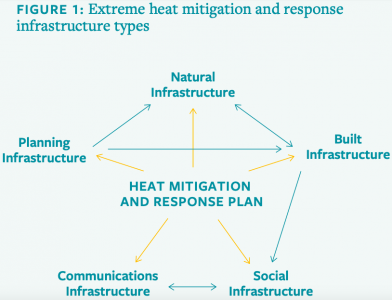The Northwest Extreme Heat Wave Is a Call to Policy Action
Extreme heat in the Pacific Northwest over the past few weeks shattered records – 108º in Seattle, 116º in Portland, 121º in Lytton, BC, the day before a wildfire devastated the town – and has been linked to hundreds of deaths, a number that will surely increase as local officials gather more information. It has melted streetcar infrastructure, buckled roads, and threatened crops. It is an unmistakable climate change disaster, and unsurprisingly it is disproportionately affecting older, unhoused, lower-income, and other vulnerable populations.
The temperatures are shocking in the absolute, but they are especially destructive because the typically cool region is not prepared to handle them – relatively few homes have air conditioning, governments aren’t as ready to set up cooling centers, and residents aren’t as accustomed to altering their routines to avoid health risks. But while the rest of the country may be more equipped to cool our interior spaces, we are equally unprepared to address our extremely hot future.
Heat will disrupt transportation networks, inhibit student achievement, and kill tens of thousands annually if we do not develop effective mitigation and response plans. Given the all-encompassing nature of the threat, these solutions must be comprehensive – involving public health and emergency services; parks, public works, and building departments; schools and libraries; employers and landlords; community organizations; and more – and they need to include five types of infrastructure:

Unfortunately, to date we have developed very few regulatory and policy mechanisms to incentivize or invest in this type of planning. Assembly Bill 585, currently progressing through the legislature, represents an important step: in addition to creating a coordinated state heat resilience program, it would use grant funds to incentivize local governments to adopt “comprehensive heat action plans” that include multiple of these infrastructure elements.
New leadership roles such as Miami’s Chief Heat Officer will support effective development of these plans. Other measures, such as California’s existing Heat Illness Prevention standard for outdoor workers, will also play a key part in protecting workers and residents. These strategies should be expanded and replicated as local governments marshal all of the public and private capacities needed to confront heat.
Creating mitigation and response plans is only a first move, and a long overdue one at that. Actually implementing them will require significant investment (and potentially innovations in risk transfer) when funding for all climate mitigation and resilience efforts is woefully limited. But given the recent experience in the Pacific Northwest, it is clearly a vital step.
Reader Comments
2 Replies to “The Northwest Extreme Heat Wave Is a Call to Policy Action”
Comments are closed.







let’s put things in a perspective. it isnt like the Northwest never has had 100 degree temps in the past. it tipped the historic highs by a few degrees. that is called weather. next thing, you’ll start blaming the sunset on climate change.
Ted, EXCELLENT recommendation, especially since time has run out because recent climate change disasters prove beyond all doubt that today is the day that Legal Planeteers must UNITE to immediately expedite actions to implement your “Call to Policy Action.”